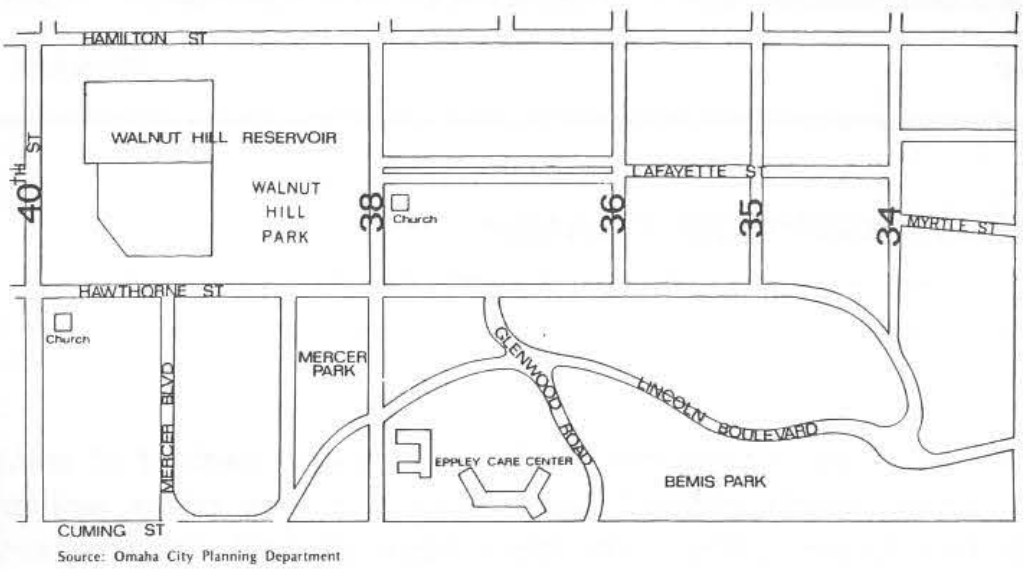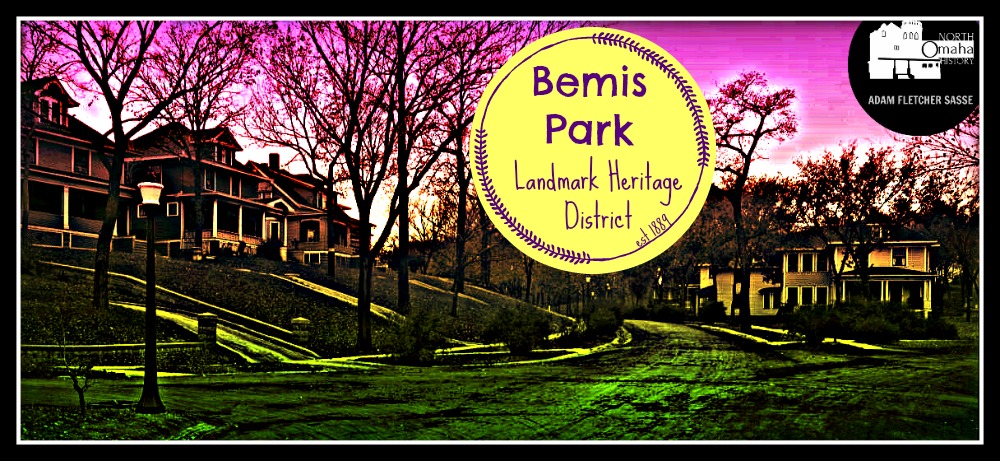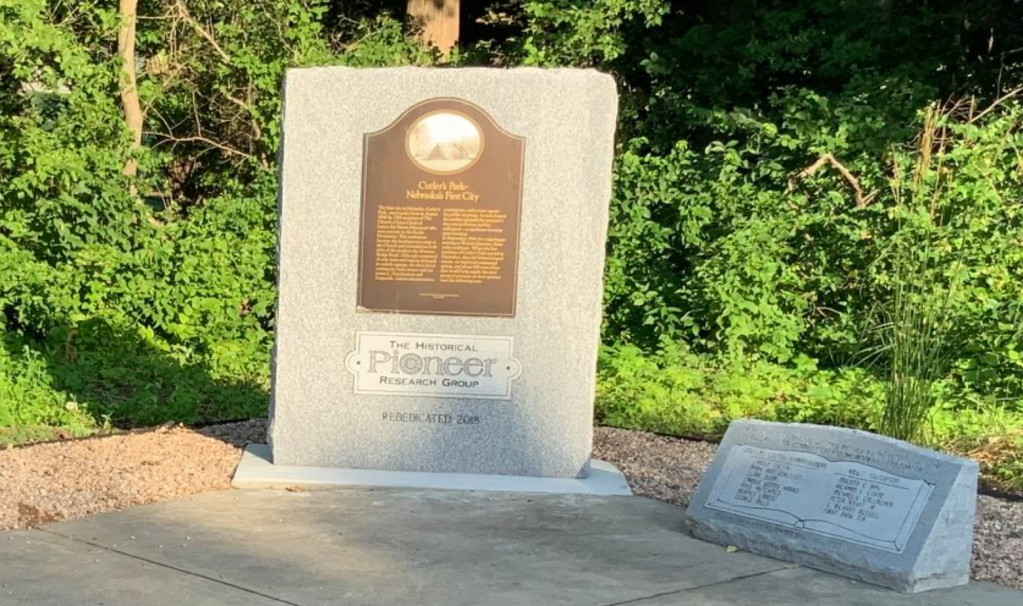Imagine walking along tree-lined streets with huge leafy canopies among lovingly committed and wholly empowered neighbors determined to maintain the beauty of a historic and grandiose neighborhood. Swirling drives leading through beautiful single-family homes that, even with a history of race-restrictive housing covenants enforced into the 1960s, form a grand neighborhood which embraces diversity and is working to make peace among its blocks. It is consistently coming back from a blighted era between the 1950s and 1970s, and is making strides all the time, and is home to a historically committed Lutheran congregation struggling to bring peace and justice to Omaha.
Can you see Victorian-era architecture styles in force? In your imagination, envision Queen Anne, Dutch Gramble, Craftsman, Stick/Eastlake, Second Neo-Classical Revival and Neo-Colonial Revival, along with great sidewalks, historic lampposts, historic park and good upkeep. With houses mostly built between 1899 and 1911, can you see this neighborhood surviving and thriving, even after being pummeled by the 1913 Easter Sunday Tornado? What would it be like to live in a small neighborhood with THREE city parks (Bemis, Walnut Hill and Mercer Park)? And among it all is one of the best-known Queen Anne style homes in the Midwest.
This neighborhood exists and is thriving in North Omaha today. It is called Bemis Park, and has been named the Bemis Park Landmark Heritage District by the City of Omaha. This article is an introduction to this important place. Please leave a comment below if there’s unique information you have to share or something specific you’d like to learn about.
A History of the Neighborhood

Extending from Cuming Street to Hawthorne Avenue, North 40th to North 33rd Street, the Bemis Park Landmark Heritage District is one of the shiniest jewels in the crown of North Omaha’s historic places.
Built to be extravagant, Omaha’s first mayor, Jesse Lowe, originally owned the land, and it was called Lowe’s Farm. In the 1870s, an Omaha real estate mogul named George Bemis built the neighborhood for business leaders, lawyers and doctors. Bemis was a colorful character who was tied up with the UP railroad and Francis Train. After landing permanently in Omaha and becoming wealthy, he established his neighborhood and became mayor of Omaha. The neighborhood was annexed into Omaha in 1887 as a suburban development at the end of the Cuming Street streetcar line. Bemis himself served as mayor from 1892 to 1896.
A New York landscape architect named Alfred D. Edgerton platted the neighborhood’s rolling streets and rounded corners. Through the 1940s, fine homes were built and thoroughly maintained, even after the horror of the Easter 1913 tornado. However, by the 1950s, white people were divesting from Bemis Park in because of its proximity to Omaha’s African American community. Split into apartments and owned by slumlords, the neighborhood suffered through the 1970s.
However, vigorous preservation advocates focused on saving the fine Victorian-era homes and lavish landscaping pushed for new city zoning to encourage rehabilitation, and it worked. In 1983, the district was designated an Omaha Landmark by the City of Omaha.
Today, the neighborhood retains its historic relevance and awesomeness, and is a role model for many Omaha neighborhoods. The neighborhood includes a beautiful park, once home to a lagoon and now to tennis courts and a slow walkway. Many of the homes have been lovingly restored to their historical elegance, and others are awaiting the process eagerly.
Bemis Park provides a role model for nearby neighborhoods, and fits well with the Gold Coast Historic District next door. It also shows hope for other fine North Omaha neighborhoods I’ve highlighted throughout this website.
The Most Popular House in Omaha

Perhaps the most popular house in the entire city of Omaha is in the Bemis Park neighborhood. The Edward Zabriskie Mansion was built in 1889 at 3524 Hawthorne Avenue. Designed by architects Fowler and Beindorff, the home has awesome Stick / Eastlake features all over its sophisticated exterior, and from pics shared by the owner, it has been excellently restored on the inside.
One of the first homes in Bemis Park, the Zabriskie Mansion is one of the finest Queen Anne style structures ever in Omaha. The house was built by Edgar Zabriskie (b 1840 d 1940), who was a ship officer, American Civil War veteran, Union Pacific general agent and accountant. It was built for a ship’s officer, American Civil War veteran, Union Pacific general agent and accountant. He and his wife had four kids; three died very young. His remaining son, Edgar Britton Zabriskie (b 1888 d 1968) inherited the house. He was married to Mary, who died in 1958. They had no children. During the last decade of Edgar Britton’s life, the house wasn’t taken care of and began deteriorating. The entire family is buried in Prospect Hill Cemetery, and the younger Zabriskie’s burial might have been the last new grave there.
Luckily, its restoration began in the early 1970s. Multiple wall surfaces, high multiple rooftops, a round turret, straight and round-arched windows and prominent gables and chimneys have been preserved excellently, and the house is in excellent condition today.
The Zabriskie Mansion is known nationally as a significant example of its style. A variety of tributes and honors have been made towards the house, and it deserves every accolade its receives. Regarded as one of America’s most beautiful “Painted Ladies,” today its included in many conversations about the restoration and rejuvenation of Victorians across the country.
Its also worth noting that the 1888 Zabriskie Carriage House at 1111 North 36th Street has been spectacularly restored, too, and has its own important legacy intact. Both of these structures were listed on the National Register of Historic Places in 1978 and as part of the Bemis Park Landmark Heritage District, they were declared official Omaha Landmarks in 1980.
More Historic Houses




Click on the pics above to enlarge the images.
There are more than 50 remarkable historic homes in the Bemis Park neighborhood. Some of them include:
- Byles House, 3302 Lincoln Boulevard (1904)
- Findley House, 3602 Lincoln Boulevard
- Hanson House, 3402 Lincoln Boulevard (1908)
- Porter/Thomsen Residence, 3426 Lincoln Boulevard (1902)
- Bliss House, 3606 Lincoln Boulevard (1908)
- Belden House, 3506 Hawthorne Avenue (1904)
- Negele House, 3515 Hawthorne Avenue (1915)
- Haubens House, 3509 Hawthorne Avenue (1903)
- Lehnoff House, 3419 Hawthorne Avenue (1907)
- Adams House, 3429 Hawthorne Avenue
- Holmquist House, 1106 North 36th Street (1910)
- George Lee House, 3620 Lincoln Boulevard (1899)
- Williams House, 3308 Lincoln Boulevard (1903)
- D. W. Woodard House, 3616 Lincoln Boulevard (1901)
- Frederick A. Henninger House, 3316 Lincoln Boulevard (1902)
- Harder House, 3519 Hawthorne Avenue (1899)
- Cheery House, 1028 North 33rd Street (1899)
- Sullivan House, 3315 Myrtle Street (1900)
- Barnhart House, 3416 Hawthorne Avenue (1898)
- Petersen House, 3419 Lafayette Avenue (1901)
- Wakely House, 1045 North 34th Street (1901)
- D. W. Woodard House, 3616 Lincoln Boulevard (1902)
- Berndes House, 1031 North 34th Street (1904)
- Belden House, 3506 Hawthorne Avenue (1904)
- Felterman House, 3407 Lafayette Avenue (1905)
- Olson House, 1110 North 36th Street (1910)
- Crawford Duplex, 3521-23 Hawthorne Avenue (1913)
- Wilves House, 3518 Hawthorne Avenue (1922)
Parks in the Neighborhood



These are images of the Bemis Park located at North 36th and Cuming Street in the Bemis Park Landmark Heritage District.
The Bemis Park neighborhood has three city parks. They are the Bemis Park, Mercer Park and the Walnut Hill Reservoir.
Bemis Park at 3434 Cuming Street was established in 1891 by George Bemis. Landscape architect Alfred Edgerton of Syracuse, New York designed the park around the district and Bemis donated it to the City of Omaha. Originally, it featured a large ravine and lagoon. Currently, it includes 10 acres with a playground, tennis courts, walking paths, picnic area and a shelter.
On the western edge of the neighborhood, Mercer Park was established in 1916. Bound by Nicholas on the north, North 38th on the east, Cuming on the south and Mercer Park Road on the west, Lincoln Boulevard cuts through the middle. In was included in the Omaha Park and Boulevard System listing on the National Register of Historic Places in 2013.
Streets and Transportation

As a suburban dreamland, getting to and from Bemis Park was a major issue in growing, sustaining and rehabilitating the neighborhood. Originally built as a streetcar suburb, the neighborhood’s main road is Cuming Street on its south side. Cuming was established by Dr. Sam Mercer, who’s Walnut Hill estate at North 40th Street capped the entire area. On its northern edge is the original Military Road, which jutted north and west through this area from Omaha City when the town was founded in 1854. Today this stretch of the road is called Hamilton Avenue.
The Bemis Park neighborhood’s streets actually have historical names that honored the original settlers’ family that owned the land. North 40th Street was known as Lowe Avenue; North 38th was Pleasant Avenue; North 36th was called Enos Avenue; North 35th was called Sophia Avenue; North 34th was Jesse Avenue; and North 33rd was called William Avenue. Signs to reflect these historical names were placed throughout the neighborhood in 1980. Most of the other streets in the neighborhood were included in the original 1887 plat by George Bemis. However, two remarkable drives are within the Bemis Park neighborhood.
The Mercer Park Boulevard was made in 1899. Extending approximately two blocks from Lincoln Boulevard on the south to Hamilton Street on the north, it was designed by famed landscape architect H.W.S. Cleveland in 1892. The two blocks of the Mercer Park Boulevard were included in the Omaha Park and Boulevard System listing on the National Register of Historic Places in 2013.
In 1916, the Lincoln Boulevard was paved through the Bemis Park neighborhood east-west from North 33rd Street to Mercer Boulevard. Designed by famed landscape architect H.W .S. Cleveland in 1892, all 1.3 miles of Lincoln Boulevard were included in the Omaha Park and Boulevard System listing on the National Register of Historic Places in 2013.
John A Creighton Boulevard runs through the Orchard Hill neighborhood and intersects with Hamilton at the northern edge of the Bemis Park neighborhood, too.
Religious Legacies

One of the notable absences in the Bemis Park neighborhood are churches. However, there is a deep history that’s still reflected in its remaining major house of worship. Zion Lutheran Church was built at North 36th and Lafayette Street in 1906. The Augustana Lutheran Church was designed by Noel Stanley Wallace at 3647 Lafayette Avenue and built this year. Formed with members from the Immanuel Swedish Lutheran and the former Zion German Lutheran, WWII delayed their plans to construct a new church. Finished in 1950, today the church continues serving an important role for the entire North Omaha community. As part of the Bemis Park Landmark Heritage District, Augustana was designated an official Omaha Landmark in 1980. It was featured in the 1966 Oscar-nominated documentary, A Time for Burning.
Another religious legacy in the neighborhood was the Methodist Episcopal Hospital. The Methodist Episcopal Hospital and Deaconess’ Home Association started in 1891 at St. Mary’s Avenue and S. 20th Street. In 1908, they moved their facility to a grand house at 923 North 38th Street on the edge of the Bemis Park neighborhood. In 1917, a grand new facility was built facing 3612 Cuming Street. It had 128 beds, and the hospital expanded and remained there until 1968. After moving to another neighborhood, the building became a cancer center and then a Salvation Army facility. In 2017, they demolished the 1917 building to build a new facility suiting their needs.
In 1992, the Nebraska Zen Center opened a new center at 3625 Lafayette Avenue in the Bemis Park neighborhood. Originally opened in 1977, today it is one of the oldest Zen centers in the United States.
Today in Bemis Park

Right now, you can go drive around the Bemis Park neighborhood. Soak in the tree-lined drives and gorgeous homes. Look at the unkept houses and imagine yourself becoming fiscally invested in Omaha history. Then go take action!
The Bemis Park Landmark Heritage District is a spectacular neighborhood filled with history and opportunity. Discover the future in its history today!
You Might Like…
- A History of the Orchard Hill Neighborhood
- A History of the Walnut Hill Neighborhood
- A History of the Walnut Hill Reservoir
- A History of the Intersection of North 40th and Hamilton
- A History of North Omaha’s Cuming Street
MY ARTICLES ABOUT HISTORIC NEIGHBORHOODS IN NORTH OMAHA
National Register of Historic Places Historic Districts in North Omaha: 24th and Lake Historic District | Benson Downtown Historic District | Country Club Historic District | Dundee/Happy Hollow Historic District | Fairacres Historic District | Fort Omaha Historic District | Minne Lusa Historic District | Nicholas Street Historic District
Historic Neighborhoods in North Omaha: Bedford Place | Belvedere Point | Bemis Park | Benson | Briggs | Bungalow City | Carter Lake, Iowa | Central Park | Clifton Hill | Collier Place | Creighton University | Crown Point | DeBolt | Druid Hill | East Omaha | Fairfax | Florence | Florence Field | Fort Omaha | Fontenelle View | Gifford Park | Gold Coast (Cathedral) | High Point | Jefferson Square | Kellom Heights | Kountze Place | Lakewood Gardens | Little Russia | Long School | Malcolm X Memorial | Miller Park | Miller Park Duplex Historic District | Monmouth Park | Montclair | Near North Side | North Downtown Omaha | Omaha View | Orchard Hill | Plum Nelly | Prettiest Mile in Omaha | Prospect Place | Raven Oaks | Redman | Saratoga | Sherman | Squatter’s Row | Sulphur Springs | Ponca Hills | Wakonda | Walnut Hill | Winspear Triangle | Wyman Heights
Lost Towns in North Omaha: Benson | Briggs | Cutler’s Park | DeBolt | East Omaha | Florence | Saratoga | Sulphur Springs | Winter Quarters
Elsewhere Online
- “Bemis Park Landmark Heritage District” by the City of Omaha Landmark Heritage Preservation Commission
- “Bemis Park’s historic touches, personal stories make these streets a joy to walk,” by Blake Ursch for the Omaha World-Herald on Jun 28, 2015.
- Bemis Park Neighborhood Association on the Midtown Neighborhood Alliance website
BONUS PICS!





Click on the images above to enlarge them and see the images closer.







These are early 20th century postcard images of Bemis Park.








Leave a comment